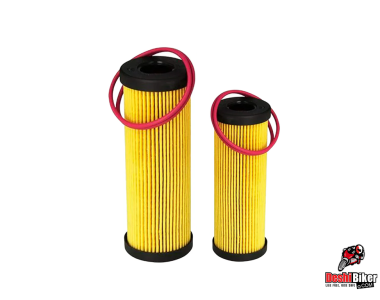What do you mean by telescopic forks or suspension? What is the Function of Telescopic Fork? Also, What are the advantages of telescopic forks? What are the disadvantages of a telescopic fork? Moreover, What is the use of telescopic suspension? Find details about the telescopic suspension including its function, purpose, pros, cons, and comparison with other types.
What is Telescopic Suspension in Bike?
A telescopic suspension is a sort of front suspension in a motorbike. You may also call it a Telescopic fork. It is the most common suspension type. It features stanchions or simply a pair of metal tubes. The stanchions slide into outer tubes. Those outer tubes are called sliders. They carry springs and dampers. Stanchions have attachment to the motorcycle’s front wheel. On the contrary, the chassis houses the sliders.
Why is it called Telescopic Fork?
Because of their similar way of movement, this type of suspension obtained its name “Telescopic Front Fork.” Indeed, the telescopic forks are of 2 types. The types are: upright and inverted.
How do Telescopic Forks Work?
When a bike’s front wheel encounters a bump or uneven surface the telescopic suspension comes into action. Right at that time, the suspension system compresses the springs and in turn the springs absorb the impact. On the other hand, the damping mechanism rebounds as it governs the springs’ compression rate. Hence, the suspension guarantees controlled and smooth riding.
What is the Purpose of Telescopic Suspension?
A telescopic suspension serves multiple major purposes including:
- It basically helps to resist the unnecessary motion of the spring. Indeed, absorbs the impacts when a bike goes over an uneven surface or hits a bump.
- While graduating, ensures stability.
- Make sure the rider enjoys a comfortable ride.
What are the Advantages of Telescopic Suspension?
There are numerous pros of telescopic suspensions and they are as follows:
Reliable Option and Technology: The technology is highly reliable as it has existed for many years. It’s also the most common sort of motorcycle suspension. Manufacturers widely use it in different models.
Versatility: It doesn’t matter whether your bike is a commuter or a cruiser, the telescopic suspension can serve you for almost all sorts of bikes.
Simplicity: Appears with a simple design. The manufacturing process is simple and so is the maintenance. Thus it leads to a lower production and maintaining cost.
Cost-Effective: The mentioned suspension type is more affordable than the other types. With less manufacturing cost the buying cost is also less. And the same story for the expense behind maintenance.
What are the Disadvantages of a Telescopic Fork?
Now let’s turn towards the cons of the telescopic suspension system in a motorcycle.
- Telescopic forks can flex under heavy braking or aggressive riding. It’s because of stanchions’ bottom-based location and also due to their responsibility to bear the most loads.
- The above scenario leads to less precise handling. It affects the highest level performance of the bike.
- This type of suspension is designed in such a way that there is increased unsprung weight. It affects the handling dynamics. However, the problems will be severe during performance-based riding rather than daily commuting circumstances.
Which Suspension is Better, Telescopic or USD?
Here are some of the key differences between the 2 types of suspension.
| Telescopic Suspension | USD Suspension |
| Most suitable for commuter purposes and casual riders. | If you prefer performance-oriented riding, than it will be the best bet for you. |
| When you go on daily commuting or weekend rides, it is enough for you. | You can rely on it for aggressive riding, twisty roads, as well as racetrack performance. |
| The handling precision is actually enough for daily use. | Best choice for high-stress conditions. Ensures improved handling, reduced flex, and greater stability. |
| The design is simpler and also its maintenance process. | The maintenance cost is higher for such suspensions and don’t forget its design complexity. |
| Relatively lower manufacturing and maintenance costs make it a more cost-effective option. | With advanced design and performance features, it is an expensive option. |
| Suitable for different sorts of motorbikes and also various riding conditions. | High-performance offering sports motorcycles feature this type of suspension. |
| In case of aggressive riding or heavy braking, it may fail to provide good enough performance. | Suits aggressive riding. Enable to handle heavy loads, ensures enhanced stability as well as precision. |
| With its decent classy looks, best suitable for cruiser types and classic bikes. | Their appearance is also aggressive and modern, best suited to the sports bikes. |
| Reliable technology. With long-term existence, it has gained the trust of the manufacturers and users. Also very widely used. | The technology is more advanced. High optimal performance. |
| Heavier at the bottom. With more unsprung weight, it moderately affects the dynamics. | The weight distribution is more even. The unsprung weight is also lower. Comes with improved traction and bump absorption. |
From the above chart, you can simply notice that the Telescopic Suspension is good enough for daily rides. It is quite reliable and won’t make you suffer more. But it is not good enough for high-performance or bikes that suit aggressive riding. So, for those cases, the USD suspension will be the best choice. Because it is more advanced and the overall better performer. But you must remember that budget is also a factor. If budget is an issue for you and hence you are asking for a cost-effective option, then the Telecsopic forks should be your choice. Spend less, and enjoy normal riding with telescopic suspension. And if you wanna spend higher, then USD suspension is your bet.


























